History
Francesco Maringhi, procuratore of the church of Sant'Ambrogio, left money after his death in 1441 for a new painting at the high altar of the church. Bills of the payments for the work until 1447 have been preserved.
In the late 1430s, brother Filippo Lippi had left the convent of the Carmine convent to open an artist workshop of his own; however, having no money enough to pay assistants and apprentices, he worked alone with two usual collaborators, Fra Carnevale and Fra Diamante, along with an unknown "Piero di Lorenzo dipintore". For the Coronation of the Virgin, however, Lippi had to call in a total of six external painters, who were responsible also for the gilded frame, now lost. Originally the work had a predella, also lost, with the exception of a small panel with a Miracle of St Ambrose, now in the Berlin State Museums.
The work was immediately admired and was copied by numerous painters. It remained in Sant'Ambrogio until 1810, when it was stolen. Later it was sold to the Galleria dell'Accademia, from which it was transferred to the Galleria degli Uffizi in Florence.
Description
The work is composed of a single panel, divided into three sectors by the arches. At the sides of the central arch are two tondos , depicting the Angel of Annunciation and the Virgin.
The main scene features a crowd of biblical figures, angels and saints, portrayed in informal positions; most of them are probably portraits of existing people. As usual, the scene is set in Heaven, but Lippi decided to avoid the outdated gilded background, replacing it with a striped sky which alludes to the seven sectors of the Paradise. In the middle, in a commanding position, are Christ and the kneeling Madonna who is going to be crowned, within a majestic marble throne in perspective. The latter includes the shell-shaped niche, featured in other paintings by Lippi.
Four angels hold a gilded ribbon, while in the lower level is a series of kneeling saints; on the left and right are other two groups of saints and angels, inspired to the crowded choirs of older works, such as the Incoronation of the Virgin by Lorenzo Monaco. The elevated pavement of the side groups creates a perspective triangle whose apex is the Virgin's head.
Amongst the figures in the middle can be recognized Mary Magdalene and St. Eustace (titular of one of the most important altars in the church) with his sons and his wife. These figures are shorter than normal, as the painter imagined them to be correctly seen from below, in perspective, by the nuns of the Sant'Ambrogio convent from their separated choirs.
Kneeling at the side are the work's commissioner, facing a cartouche with the write ISTE PERFECIT OPUS ("this one finished the work"), while on the left is a self-portrait of Filippo Lippi in the religious habit of a Carmelite friar (as he was). Standing on the sides are the two titular saints of the church: St. Ambrose (left) and St. John the Baptist (right), whose austere representation reveal the influence of Masaccio.
This painting is described at length in lines 344-389 of Robert Browning's poem 'Fra Lippo Lippi', published in 1855 in his collection Men and Women .

Fra Angelico, OP was a Dominican friar and Italian painter of the Early Renaissance, described by Giorgio Vasari in his Lives of the Artists as having "a rare and perfect talent". He earned his reputation primarily for the series of frescoes he made for his own friary, San Marco, in Florence, then worked in Rome and other cities. All his known work is of religious subjects.

Filippino Lippi was an Italian painter working in Florence, Italy during the later years of the Early Renaissance and first few years of the High Renaissance.

Andrea del Castagno or Andrea di Bartolo di Bargilla was an Italian Renaissance painter in Florence, influenced chiefly by Masaccio and Giotto di Bondone. His works include frescoes in Sant'Apollonia in Florence and the painted equestrian monument of Niccolò da Tolentino (1456) in Florence Cathedral. He in turn influenced the Ferrarese school of Cosmè Tura, Francesco del Cossa and Ercole de' Roberti.

Lorenzo Monaco was an Italian painter and miniaturist of the late Gothic to early Renaissance age. He was born Piero di Giovanni. Little is known about his youth, apart from the fact that he was apprenticed in Florence. He has been considered the last important exponent of the Giotto style, before the Renaissance revolution that came with Fra Angelico and Masaccio.

Domenico di Michelino (1417–1491) was an Italian Renaissance painter who was born and died in Florence. His real name was Domenico di Francesco. The patronymic "di Michelino" was adopted in honour of his teacher, the cassone painter Michelino di Benedetto, by whom no works have been identified. Giorgio Vasari reports that Domenico was also a pupil of Fra Angelico, whose influence is reflected in many of Domenico's paintings along with that of Filippo Lippi and Pesellino.

Filippo Lippi, also known as Lippo Lippi, was an Italian painter of the Quattrocento and a Carmelite priest. He was an early Renaissance master of a painting workshop, who taught many painters. Sandro Botticelli and Francesco di Pesello were among his most distinguished pupils. His son, Filippino Lippi, also studied under him and assisted in some late works.
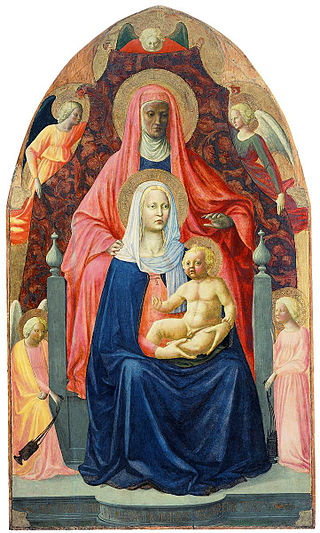
The Madonna and Child with St. Anne, also known as Sant'Anna Metterza, is a painting of c. 1424-1425 by the Italian Renaissance painter Masaccio, probably in collaboration with Masolino da Panicale. The painting is in the Galleria degli Uffizi in Florence, Italy, and measures 175 centimetres high and 103 centimetres wide.

Sant'Ambrogio is a Roman Catholic church in Florence, region of Tuscany, Italy. It is named in honour of St Ambrose.
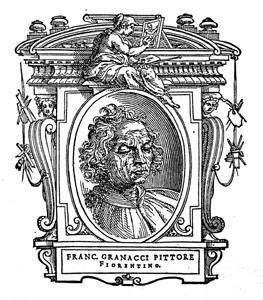
Francesco Granacci was an Italian Renaissance painter active primarily in his native Florence. Though little-known today, he was regarded in his time and is featured in Giorgio Vasari's Lives of the Artists.
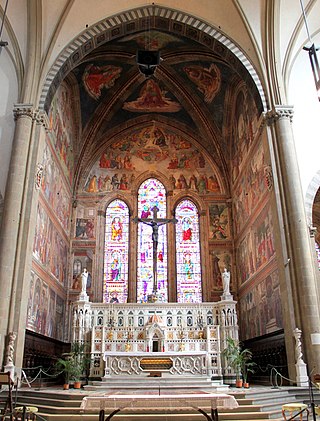
The Tornabuoni Chapel is the main chapel in the church of Santa Maria Novella, Florence, Italy. It is famous for the extensive and well-preserved fresco cycle on its walls, one of the most complete in the city, which was created by Domenico Ghirlandaio and his workshop between 1485 and 1490.

The Coronation of the Virgin or Coronation of Mary is a subject in Christian art, especially popular in Italy in the 13th to 15th centuries, but continuing in popularity until the 18th century and beyond. Christ, sometimes accompanied by God the Father and the Holy Spirit in the form of a dove, places a crown on the head of Mary as Queen of Heaven. In early versions the setting is a Heaven imagined as an earthly court, staffed by saints and angels; in later versions Heaven is more often seen as in the sky, with the figures seated on clouds. The subject is also notable as one where the whole Christian Trinity is often shown together, sometimes in unusual ways. Crowned Virgins are also seen in Eastern Orthodox Christian icons, specifically in the Russian Orthodox church after the 18th century. Mary is sometimes shown, in both Eastern and Western Christian art, being crowned by one or two angels, but this is considered a different subject.

The Coronation of the Virgin is a 1414 tempera on panel polyptych by the Italian late Gothic artist Lorenzo Monaco, centred on the subject of the Coronation of the Virgin. Once in the Camaldolese monastery of Santa Maria degli Angeli, it is now housed in the Uffizi Gallery in Florence. It is dated February 1413 which, in the Florentine calendar, corresponded to 1414.

The Coronation of the Virgin is a painting of the Coronation of the Virgin by the Italian early Renaissance painter Fra Angelico, executed around 1432. It is now in the Uffizi Gallery of Florence. The artist executed another Coronation of the Virgin, now in the Louvre in Paris.

The Coronation of the Virgin is a painting by the Italian early Renaissance master Fra Angelico, executed around 1434–1435 in Fiesole (Florence). It is now in the Musée du Louvre of Paris, France. The artist executed another Coronation of the Virgin, now in the Uffizi in Florence.
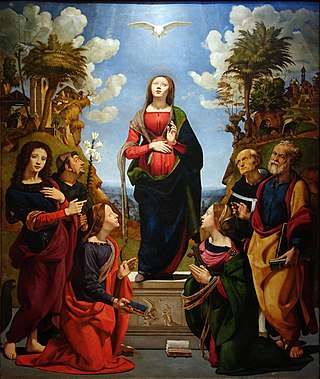
The Immaculate Conception with Saints is a painting by the Italian Renaissance painter Piero di Cosimo, executed between 1485 and 1505. It is housed in the Uffizi Gallery of Florence, Italy.

The Barbadori Altarpiece is a painting by Filippo Lippi, dated to 1438 and housed in the Louvre Museum of Paris.

The Marsuppini Coronation is a painting of the Coronation of the Virgin by the Italian Renaissance painter Filippo Lippi, dating to after 1444. It is in the Pinacoteca Vaticana, Rome.

Madonna with Child is a painting by the Italian Renaissance artist Filippo Lippi. The date in which it was executed is unknown, but most art historians agree that it was painted during the last part of Lippi's career, between 1450 and 1465. It is one of the few works by Lippi which was not executed with the help of his workshop and was an influential model for later depictions of the Madonna and Child, including those by Sandro Botticelli. The painting is housed in the Uffizi Gallery, Florence, Italy, and is therefore commonly called “The Uffizi Madonna” among art historians.
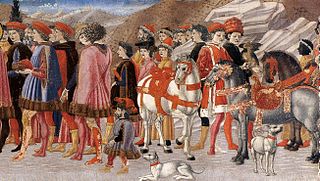
Giovanni di Francesco del Cervelliera or Giovanni di Francesco was an Italian Renaissance painter, active in Florence in the mid-fifteenth century.

Apparition of the Virgin to St Bernard is an oil-on-wood painting by Italian artist Fra Bartolomeo, datable to 1504–1507. It is held in the Uffizi, in Florence.




















